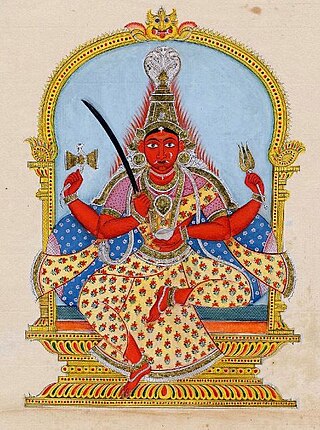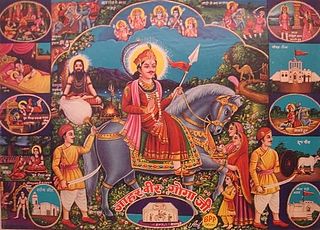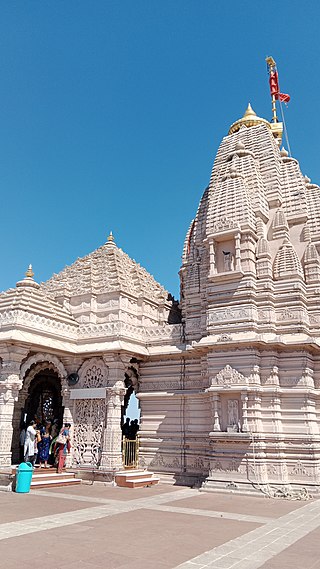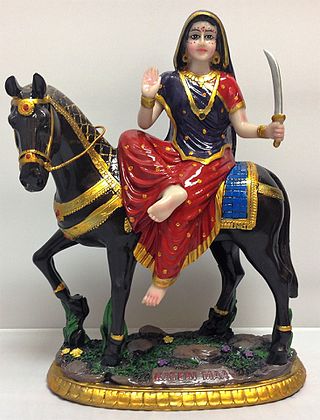
Mariamman, often abbreviated to Amman, is a Hindu goddess of weather, predominantly venerated in the rural areas of South India. Her festivals are held during the late summer/early autumn season of Ādi throughout Tamil Nadu and the Deccan region, the largest being the Ādi Thiruviḻa. Her worship mainly focuses on bringing rains and curing diseases like cholera, smallpox, and chicken pox. Mariamman is worshipped in accordance with local traditions such as Pidari or the Gramadevatai. She is considered as a guardian deity by many South Indian village-dwellers.

Gogaji is a folk deity, worshipped in the northern states of India especially in Rajasthan, Himachal Pradesh, Haryana, Uttarakhand, Punjab region, Uttar Pradesh, Jammu and Gujarat. He is a warrior-hero of the region, venerated as a saint and a 'snake-god'.

In Jain cosmology, Chakeshvari or Apraticakra is the guardian goddess or Yakshini of Rishabhanatha. She is the tutelary deity of the Sarawagi Jain community.

Kuldeep Manak, also spelled as Kuldip Manak, was an Indian singer best known for singing a rare genre of Punjabi music, kali, also known by its plural form kalian or kaliyan. Manak is generally regarded as one of the greatest Punjabi artists of all time. His high pitched strong voice was unique, and instantly recognisable. A statue of Manak has been erected in Ludhiana near his residence as a tribute.

Vasant Panchami, also rendered Vasanta Panchami and Saraswati Puja in honour of the Hindu goddess Saraswati, is a festival that marks the preparation for the arrival of spring. The festival is celebrated in Indian religions in different ways depending on the region. Vasant Panchami also marks the start of preparation for Holika and Holi, which take place forty days later. The Vasant Utsava (festival) on Panchami is celebrated forty days before spring, because any season's transition period is 40 days, and after that, the season comes into full bloom.

Sheetalalit. '"coolness"', also spelled as Shitala and Seetla, is a Hindu goddess venerated primarily in North India. She is regarded to be an incarnation of the goddess Parvati. She is believed to cure poxes, sores, ghouls, pustules, and diseases, and most directly linked with the disease smallpox. Sheetala is worshipped on Tuesday Saptami and Ashtami, especially after Holi during the month of Chaitra. The celebration of the goddess Sheetala on the seventh and eighth day of the Hindu month is referred to as the Sheetala Saptami and Sheetala Asthami, respectively.

Oladevi is the goddess of cholera and is worshipped by people of Bengal region and Marwar, Rajasthan. The goddess is also known as Olaichandi, Olabibi and Bibima. She is venerated by Hindus and Muslims of Bengal.

Jwala Ji is a Hindu goddess. The physical manifestation of Jwala Ji is always a set of eternal flames, and the term Jvala means flame in Sanskrit and ji is an honorific used in the Indian subcontinent.

Shashthi or Shashti is a Hindu goddess, venerated in Nepal and India as the benefactor and protector of children. She is also the deity of vegetation and reproduction and is believed to bestow children and assist during childbirth. She is often pictured as a motherly figure, riding a cat and nursing one or more infants. She is symbolically represented in a variety of forms, including an earthenware pitcher, a banyan tree or part of it or a red stone beneath such a tree; outdoor spaces termed shashthitala are also consecrated for her worship. The worship of Shashthi is prescribed to occur on the sixth day of each lunar month of the Hindu calendar as well as on the sixth day after a child's birth. Barren women desiring to conceive and mothers seeking to ensure the protection of their children will worship Shashthi and request her blessings and aid. She is especially venerated in eastern India.
Punjabi festivals are various festive celebrations observed by Punjabis in Pakistan, India and the diaspora Punjabi community found worldwide. The Punjabis are a diverse group of people from different religious background that affects the festivals they observe. According to a 2007 estimate, the total population of Punjabi Muslims is about 90 million, with 97% of Punjabis who live in Pakistan following Islam, in contrast to the remaining 30 million Punjabi Sikhs and Punjabi Hindus who predominantly live in India.

Naugaja Peer was a saint whose height was 9 "gaj" which in Indian metric units equals 8 meters and 36 inches or 27 feet. An explanation is that peer was likely surrounded by his nine men making 27 feet rectangular border to save him His name was Syed Ibrahim Badshah, who is believed to ensure safe journeys and completion of all works in time.

Vasanta, also referred to as Basant, refers to the Indian spring.

Punjabi folk music is the traditional music on the traditional musical instruments of the Punjab region of the Indian subcontinent. There is a great repertoire of music from the time of birth through the different stages of joy and sorrow till death. The folk music invokes the traditions as well as the hardworking nature, bravery and many more things that the people of Punjab get from its gateway-to-India geographical location. Due to the large area with many sub-regions, the folk music has minor lingual differences but invokes the same feelings. The sub-regions, Malwa, Doaba, Majha, Pothohar, and hills areas, have numerous folk songs. Punjabi dance OP Bhangra music which is a genre of Punjabi modern music invented in Britain by the Punjabi diaspora.

Kālikā Mata Temple is a Hindu goddess temple complex and pilgrim centre at the summit of Pavagadh Hill in Panchmahal District, India, with in the Champaner-Pavagadh Archaeological Park. It dates from the 10th or 11th centuries. The temple has three images of goddesses: the central image is of Kalika Mata, flanked by Kali on the right and Bahucharamata on the left. On Chitra sud 8, a fair is held at the temple which is attended by thousands of devotees. The temple is the site of one of the Great holy Shakti Peethas. One can easily reach the temple by ropeway.

Kateri Amman, also abbreviated to Kateri, is a Hindu goddess. Her worship originates in the Dravidian folk religion, that is classified under Hinduism.
Sheetla Mata Temple is a Hindu temple dedicated to the goddess Shitala (Sheetla), wife of Guru Dronacharya who was the teacher of the Pandavas and Kauravas according to an Indian epic Mahabharata. The temple is located on Sheetla Mata Road in old Gurugram city of Gurugram district in the state of Haryana in India.

The following outline is provided as an overview of and topical guide to Punjab:
Punjabis are the majority ethnic group in Pakistan. They celebrate a number of religious and cultural festivals:
Folk practices prevalent in Punjab incorporate local mysticism and refers to the beliefs and practices strictly indigenous to the Punjabi people, of the Punjab region including ancestral worship, veneration of saints, and local festivals. There are many shrines in Punjab which represent the folk religion of the Punjab region which is a discourse between different organised religions. These shrines represent inter-communal dialogue and a distinct form of cultural practice of saint veneration.



















